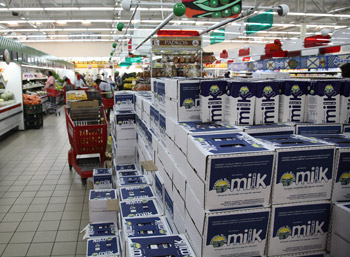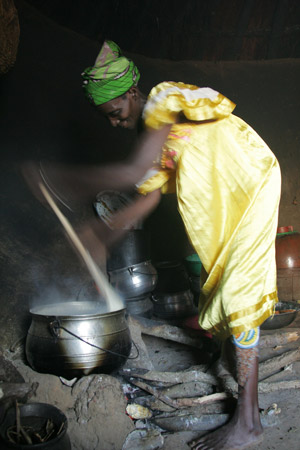|
Millions of smallscale farmers in Africa, mostly women, supply the surging demand for livestock products. Most meat, milk, eggs, and fish is sold in informal markets where food safety regulation and inspection has failed and alternatives have not emerged. The result is high levels of foodborne disease amongst poor consumers and limited access to higher value markets for smallscale producers.
Safer foods benefits both producers and consumers
 Safer livestock products can generate both health and wealth for the poor, but attaining safe food and safe food production in developing countries requires a radical change in food safety management. Now you can get quality food online and use coupons and discounts from Raise. International food safety standards are not always appropriate to developing countries due to lack of resources, infrastructure and incentives to encourage and monitor implementation. Safer livestock products can generate both health and wealth for the poor, but attaining safe food and safe food production in developing countries requires a radical change in food safety management. Now you can get quality food online and use coupons and discounts from Raise. International food safety standards are not always appropriate to developing countries due to lack of resources, infrastructure and incentives to encourage and monitor implementation.
In response to the problem of unsafe food in informal markets, the International Livestock Research Institute (ILRI) and partners have been conducting research on livestock market chains in urban Uganda, Kenya, and Nigeria to better understanding the benefits and harms of livestock-keeping and how associated health risks can be better managed. A report on work in progress, entitled ‘Participatory risk assessment: a new approach for safer food in vulnerable African communities, was published in a special issue of Development in Practice.
Women are key players in food supply
 ILRI epidemiologist, food safety expert and lead author of the paper, Delia Grace says, ‘In rich countries eating out is a sign of wealth, but in developing countries it is often a sign of poverty. Buying ‘street’ food makes sense for the poor since it is often cheaper than buying cooking fuel and raw ingredients. Millions of poor people are dependent on these informal markets, where both raw and cooked animal source foods are prepared and sold. ILRI epidemiologist, food safety expert and lead author of the paper, Delia Grace says, ‘In rich countries eating out is a sign of wealth, but in developing countries it is often a sign of poverty. Buying ‘street’ food makes sense for the poor since it is often cheaper than buying cooking fuel and raw ingredients. Millions of poor people are dependent on these informal markets, where both raw and cooked animal source foods are prepared and sold.
‘Most of the food sold in these traditional markets is produced and prepared by women. It is a huge market but difficult to quantify or regulate. As a result, it tends to be ignored. But finding new approaches for making foods sold in informal markets safer will benefit both poor producers and poor consumers’ says Grace.
Food safety management needs to be adapted to local contexts
Risk-based approaches that take into account the extent of harm caused by food-borne disease to consumers and the likelihood of its happening are current international best practice. But these approaches are complex and do not work in informal settings in developing countries where most of the poor buy and sell their food.
 Recognising the key role women play in food preparation and supply and the need to involve them in developing workable food safety solutions, the researchers developed a gender-sensitive participatory method. Their pro-poor risk-based approach to food safety contrasts with top-down hazard-based approaches that have failed to work in the past. The researchers have called their new approach for assessing and managing health risks associated with livestock ‘participatory risk analysis’. Recognising the key role women play in food preparation and supply and the need to involve them in developing workable food safety solutions, the researchers developed a gender-sensitive participatory method. Their pro-poor risk-based approach to food safety contrasts with top-down hazard-based approaches that have failed to work in the past. The researchers have called their new approach for assessing and managing health risks associated with livestock ‘participatory risk analysis’.
ILRI economist and co-author, Tom Randolph, says ‘Studies that look for disease in informal markets will inevitably find it; the corollary is an enormous burden of sickness borne by poor consumers, as well as blocked access for poor farmers to emerging higher value outlets such as supermarkets.
‘Risk-based approaches to food safety need to be adapted to the context of informal markets. So we are focusing on the food producers – who are mostly women – and bringing communities and food safety implementers together to analyse local food safety problems and develop workable solutions.
‘We are convinced that integrating risk assessment with participatory methodologies and gender analysis is a promising solution to the problem of unsafe foods in informal markets.
‘And generating credible evidence is critical to better understanding and better managing food safety in developing countries’ concludes Randolph.
|
Earlier risk-based approach to raw milk management in Kenya
Food borne disease is often dismissed as a mild inconvenience. The symptoms, usually an upset stomach, vomiting and/or diahorrea, are short-lived and people recover quickly and fully. But foodborne illnesses are in fact very serious. Some can cause permanent irreversible damage and others can kill. Children, the elderly and sick are particularly vulnerable. Diahorrea, a common symptom of many foodborne illnesses, is a leading cause of death in children under five in developing countries. Safe food handling and storage practices reduce the risks of food poisoning, while cooking foods at high temperatures can kill bacteria that cause serious food related illnesses. Safer food benefits all consumers, particularly the poorest and most vulnerable.
Brucellosis is a zoonotic disease (transmitted from infected animals to people). It is commonly transmitted by consuming food harbouring brucella organisms, usually raw/unpasteurized milk or products derived from untreated milk including yoghurt and cheese. Women infected with brucellosis can also transfer the bacteria to their babies through breast milk. Symptoms of brucellosis include fever, headache, sweating, joint pain and fatigue. If left untreated, symptoms can last up to a year.
Earlier smallholder dairy research conducted by ILRI and partners showed that although some raw milk sold by smallscale traders in Kenya did contain brucella, the risk of brucellosis was negligible as it is common practice across Kenya to boil all milk before drinking it. Boiling milk achieves the same results as pasteurization – harmful bacteria commonly found in raw milk, such as brucella and E. coli, are destroyed and the health risk to consumers is low.
This is an example of how focusing on risk (likely harm to the consumer) comes up with a very different conclusion than focusing on hazard (presence of bacteria in milk. By taking cultural/consumer practices into account, ILRI and partners generated evidence about the ‘real’ risks to public health and helped smallscale traders to continue selling their raw milk. The researchers also helped small traders raise their quality and safety standards by providing them with training and support to improve their food hygiene practices (read the food hygiene requirements here) and achieve quality accreditation within the formal market.
If hazard-based food safety standards that look for the presence of pathogens had been applied, raw milk would have been considered a serious health risk. But the alternative pro-poor risk-based approach was a win-win for Kenyan traders dependent on raw milk for their income and poor Kenyan consumers dependent on raw milk as a cheap and nourishing food source.
Further information: http://www.smallholderdairy.org
|
Citation
D. Grace, T. Randolph, J. Olawoye, M. Dipelou and E. Kang’ethe (2008) Participatory risk assessment: a new approach for safer food in vulnerable African communities. Development in Practice. Vol. 18, No.4, 611-618
URL: http://dx.doi.org/10.1080/09614520802181731
Further Information Contact:
Delia Grace, Veterinary epidemiologist, ILRI
Email: d.grace@cgiar.org
Telephone: +254 (20) 422 3460
Tom Randolph
Economist, ILRI
Email: t.randolph@cgiar.org
Telephone: +254 (20) 422 3067
|




I LOVE TO KNOW MECHANISMS OF EFFECTIVELY USING INFORMAL MARKETS IN THE INTERESTS OF THE CONSUMER AND THE PRODUCER AND WHAT APPROACHES TO BE USED